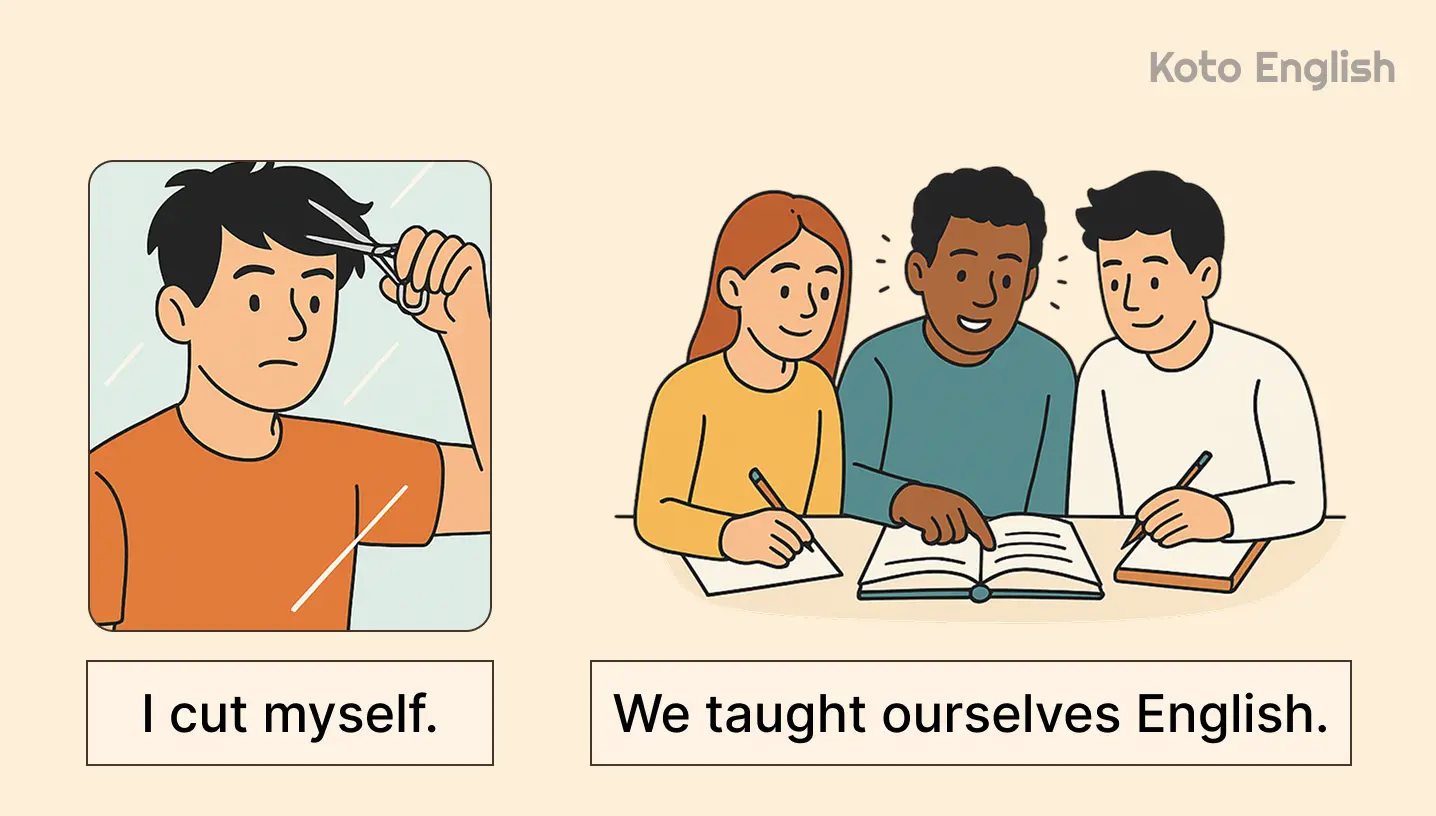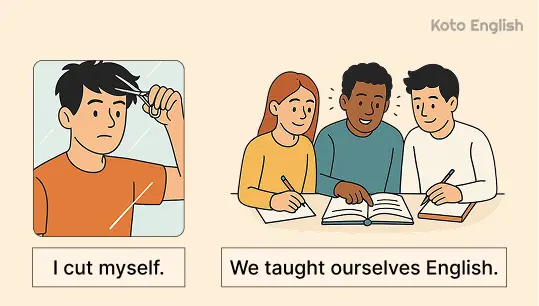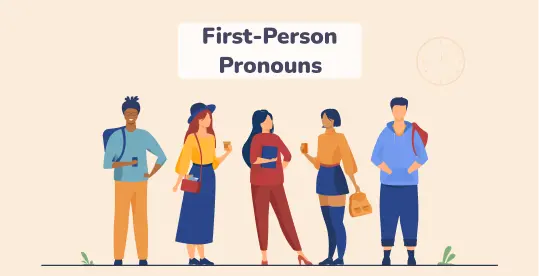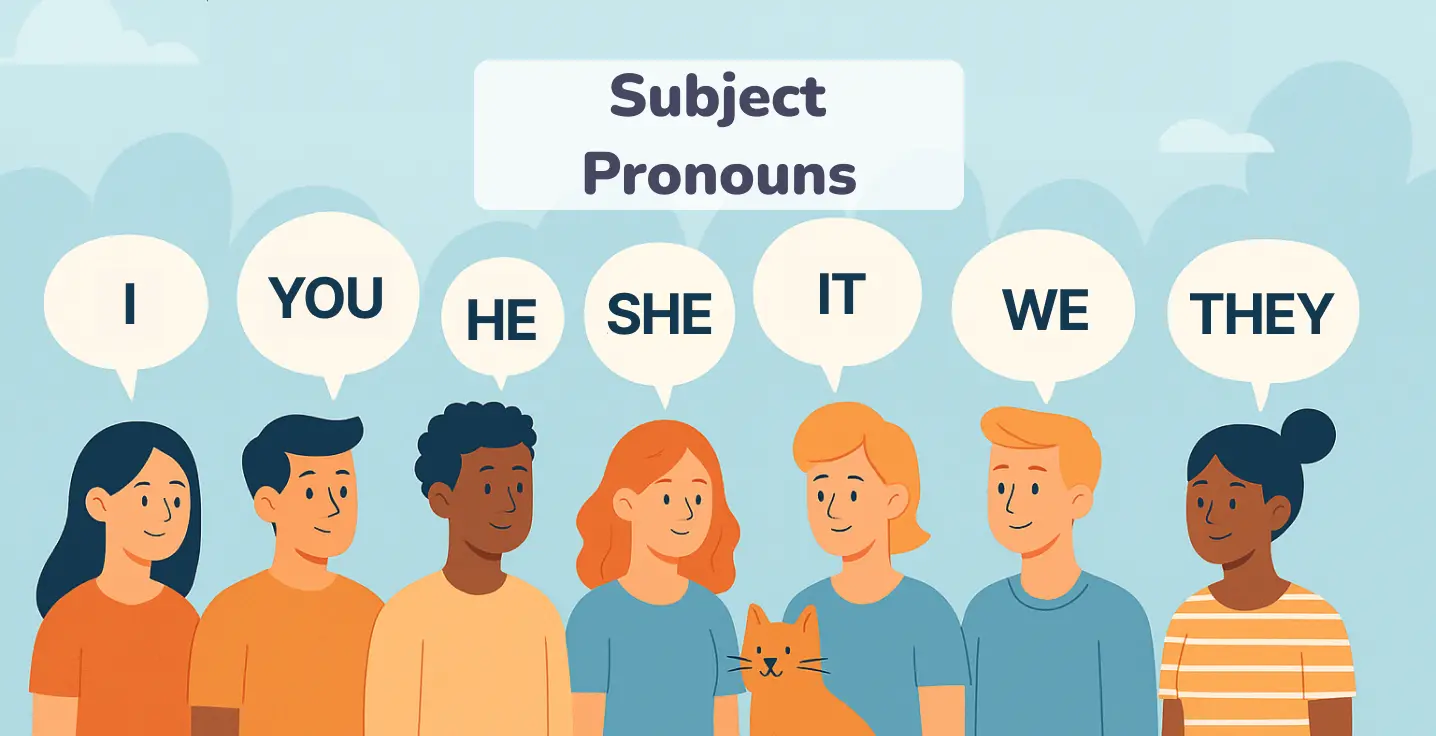What is a first-person pronoun?
First-person pronouns,
| Pronouns | Singular | Plural |
|---|---|---|
| Subject | I | We |
| Object | me | me |
| Possessive | mine | ours |
| Reflexive | myself | ourselves |
That’s how a list of first-person pronouns changes a sentence:
Without
With
The first example sounds odd, as if Maria is a robot, not a person. Pronouns help us talk about ourselves, and it is really a tough task to do so without them. They are everywhere, and now we are going to explore where we should use them.
Level up your English with Koto!
When to use them correctly?
Speaking of a first-person pronoun, think of it as your golden hour, because everything is centered around you. Using them, you make it clear that it is about you, done by yourself, and owned by you.
-
Want to share personal thoughts or information? If you like or don’t like something, or have a personal opinion about a case, or you need to introduce yourself, and provide some details about your life, it is time for pronouns.
Example:
I am not sure whether we need to call them.I am Lina.We know them.
-
Need to say that someone did for you? When someone gives you a present, tells you a secret or calls you to a party, it is important to specify it correctly, and pronouns will help you do so. These first-person pronouns examples offer a glimpse:
Example:
He gave it tome .She toldus they wanted to get married.My mom never yells atme .
-
Want to tell a story about something that happened to you? If you went on a trip and saw fascinating things or you visited a concert and the lead singer sang a song with you, explain all the details about how it was related to you.
Example:
I arrived at the airport at 7 p.m., as my mother toldme . However,I didn’t check in on time because nobody told me thatI needed to do so. That’s howI missed my flight.I needed a charger for my phone, but no one had a suitable one. Because of that,I couldn’t call a taxi, and it costme $50.
-
Plan to specify that something belongs to you? Claim what is yours by using possessive pronouns. They also help when you don’t remember how to call an object, but need to emphasize that it is yours.
Example:
This ismine .The car isours .This house belongs tome .
How to use first-person pronouns?
There are many nuances of usage, depending on where the word is and who does the action. In the table, we have structured these moments, spotlighting the role of first-person pronouns in English, their placements, and instances that demonstrate how they work.
| Type | What it indicates | Position | Examples of first-person pronouns |
|---|---|---|---|
| Subject | You do an action. | Instead of a subject, at the beginning of a sentence. |
|
| Object | Someone does an action targeted at you. | After the verb. |
He told
They invited
|
| Possessive | Helps mention that an item belongs to you. | Replaces a noun. |
That is
This project is
|
| Reflexive | You do something by yourself. | After the verb. |
I cut
We taught
|
Let’s visualize how reflexive first-person pronouns work in daily life. These real-life examples reinforce when and how to use “myself” and “ourselves” correctly.


Examples of the first-person pronoun
You saw plenty of instances in the previous sections, but here you will find as many details as you need to understand the difference between pronouns in practice. We specified singular and plural cases, as well as a conversation with a mix of possible variations to grasp the first-person pronoun meaning fully.
First-person singular
Take a look at the pronouns you should use when you talk about yourself alone. Listen and read the instances for better memorization.
| Pronouns | Example |
|---|---|
| I |
My sister and
|
| Me |
The shop sold
The tutor explained to
|
| Mine |
That jacket was
Those clothes are
|
| Myself |
|
First-person plural
When you want to mention that something was done or was directed at your family, friends, colleagues, coauthors, and you, the following first-person pronouns list is applied:
| Pronouns | Example |
|---|---|
| We |
|
| Us |
The company hired
The waiter brought
|
| Ours |
Your car is so fast!
The idea is
|
| Ourselves |
|
In a dialogue
Here, we will compile the entire scope of possible variations of first-person pronoun examples in a conversation, allowing you to view them together and recognize patterns, as well as use them correctly.


To better understand how first-person pronouns work in real conversations, take a look at the comic below. It features a short dialogue using various forms such as “I,” “we,” “my,” and “ourselves” in context.
Common mistakes
Many nuances about position and appliances can confuse even experienced English learners when grasping the first-person pronouns definition and uses. We will help you break down the rules with the collection of errors people regularly make.
Using “me” in place of “I”
You could hear the mistaken version on TV or in music, but when it comes to grammatical accuracy, it won’t work. It is better to memorize the right rules for writing and speaking appropriately. Also, remember that when you discuss what happened to you and other people, I should be in second place.
|
Me and my family always travel to Hawaii.
|
My family and I always travel to Hawaii.
|
|
Me and my girl want to but a house.
|
My girl and I want to buy a house.
|
Selecting “I” when you need to use “me”
The same mistakes occur in reverse when you choose the wrong pronouns. How to not forget that? If an action is directed at you, you need to use the object, me. If you do something, use I. Look at the example below. Who proposed? Who was proposed to?
|
He proposed to I.
|
He proposed to me.
|
|
They needed I to complete the task.
|
They needed me to complete the task.
|
Using reflexive instead of object pronouns
You use myself when you want to emphasize that you have done something by yourself. For instance, I bought a house by myself. I wrote it myself. It was your deed, not someone else’s. So, in the first column, we can see that it was me who was offered a new job, and they were us who were warned, but not we offered and not we warned.
|
He offered myself a new job.
|
He offered me a new job.
|
|
They warned ourselves about dogs.
|
They warned us about dogs.
|
Choosing “mine” instead of “my”
What is the difference between them? Both indicate possessions. There is a rule to memorise it quickly: mine is used without a noun. It is natural and right to say: This is mine if the person you are talking to understands what you mean. My requires a noun. You can’t say: It is my, even if it’s obvious what you are discussing, because my is always followed by a noun.
|
This is mine sister.
|
This is my sister.
|
|
Mine colleagues demonstrate good results.
|
My colleagues demonstrate good results.
|
Summary and actionable tips
To sum up all the points, let’s state the grammar essentials once more. The first-person pronoun definition is simple: I and we are the world you need to learn. They have additional variations when you express your thoughts regarding possessing something or telling what someone did to you. These suggestions will help you recall them effortlessly:
- Be an active reader. Pay attention to the words and try to understand the reason for a certain choice.
- Try to write sentences with each word to practice its usage.
- After reading, try to answer the question: “What are first-person pronouns?” and write down as much information as you can.
And remember, learning can be fun when you dedicate a bit of time each day.
Enjoy personalized learning!
First-person pronouns FAQ
Singular pronouns for the first-person are words used by you referring to yourself in contexts like sharing your opinion, telling of what you like and feel. I — used to specify that you do something, me — helps to say that someone does something to you, mine — possessive noun phrase (my kitchen — mine) and myself enables you to highlight that you can do something by yourself.
I, me and myself are all related to the first-person singular pronouns, but they play different roles in a sentence. I is used instead of the subject; you can start a sentence with it, me can replace the object of the sentence and myself stands in for me when the subject and object are the same.
Speaking of the grammar rules, spelling, you won’t find many differences, so our examples of a first-person pronoun will work in both cases. However, some aspects are not the same in both formats. First of all, the pronunciation is not entirely identical. Also, British English is more conservative regarding academic writing than American English.
It depends on the style you need to use. For example, if you need to write a paper following APA style (American Psychological Association), applied in social science, anthropology, and education, you use I when the research is done by you. The same is common for MLA and Chicago styles.
However, when writing technical materials in IEEE, describing experiments in chemistry in ACS, and presenting work in AMA style, writers are recommended to stick to the passive voice or third person instead of a first-person pronoun, even if you did it by yourself. To sum up, you need to check the style.







